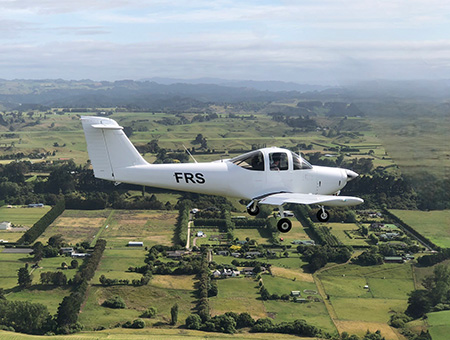By Jonathan Mauchline, CFI, Wanganui Aero Club
 After getting your pilot licence or certificate, you need to keep practising basic skills, so BFRs are a breeze, and you’re the safest pilot you can be.
After getting your pilot licence or certificate, you need to keep practising basic skills, so BFRs are a breeze, and you’re the safest pilot you can be.
I conduct biennial flight reviews for PPL-holders and microlight pilots on a pretty regular basis.
One of my standard questions is, 'How long has it been since you last practiced a forced landing? Or stall? Or glide approach?'
'Not since my last BFR' is a frequent response.
Consequently, when I check these exercises during a BFR, I’m sometimes dismayed by the pilot’s performance, particularly in forced landing or wing-drop stalling.
I get the feeling that some pilots stick their head in the sand about practising these exercises, reassuring themselves with:
- 'The last practice I did was okay.'
- 'My engine is reliable – in reality, I’ll never need this.'
- 'My instructor signed off my BFR. He thinks I’m good enough until next time.'

Photo courtesy of Wanganui Aero Club.
These, and other similar excuses, are used to convince themselves there’s no need to practice – it also protects their ego because they don’t have to face how inaccurate and uncurrent they might have become.
For others, it may simply be that they’re not comfortable practising these manoeuvres on their own. But this also indicates a problem. If a pilot isn’t comfortable practising these in a controlled training scenario, in a real-life scenario with the high pressure and possible panic factor, they’re less likely to react correctly.
But the forced landing pattern, like the low-level stall, is an activity which, when practised and current, assures the pilot they can walk away following an emergency.
I think that’s pretty important, don’t you?
How good is a ‘good enough’ FLWOP?
I’ve found some pilots, who seem perfectly comfortable with the FLWOP (forced landing without power) they just did on a BFR, fail to appreciate just how closely they 'scraped' in...
Or I find they breathe a sigh of relief when they manage to achieve a good one – as if they didn’t have any confidence in their ability to begin with.
In a real-life forced landing situation, would you not want to be 100 percent comfortable in carrying out a FLWOP?
Is it not worth one or two hours of practice to be comfortable with your ability? Remember, you’re responsible for all the occupants in your aircraft – occupants who’re helpless and rely on you to keep them safe.
Would your next passenger be comfortable if they knew you hadn’t practiced a FLWOP for more than a year? Would they be comfortable if they knew the quality of your last practiced one?
These are the questions to ask yourself when deciding whether your skills are ‘good enough’.
Often, pilots don’t want to practise a FLWOP because they’re afraid to muck it up. Surely, this is an even better reason to practice!
In how many of your last 10 FLWOP practices were you 100 percent confident in a successful outcome? Is anything less than 10 out of 10 good enough?
Ask your passenger.
The only way to get ‘good enough’ is to really practice. Glides from high altitude to practice the FLWOP pattern are a great place to start.
Practising glide approaches at your airfield is also a fantastic exercise, as every FLWOP ends up as a glide approach.
Also, by physically landing on a runway, you have a direct measure of how successful it was – was your touchdown accurately on your aiming point or did you float past, or land short? Being able to nail a glide approach, I believe, is the first step to nailing the whole FLWOP pattern.
Call up your local aero club and grab an instructor for a couple hours of practice. It’s often helpful having another pilot on board to help critique your technique, but also to keep a lookout for traffic, and handle radios and the like, so you can properly concentrate on the exercise.
Stalling
A study1 I recently read found that 80 percent of unintentional stalls occur below 1000 ft. We can infer from this that pilots are distracted when these stalls occur, whether that's by making a turn, encountering
wind shear, during approach to land, or when taking off.
These aren’t the straight and level stalls we practice at 3000 ft, which we expect and know how to recover from.
What you don’t expect, are stalls while manoeuvring, especially at low level.
Reactions are delayed, and if it develops into a wing‑drop and recovery isn’t 100 percent intuitive, you’ll start rolling wings level with ailerons, only worsening the situation.
Before you know it, your aircraft will have turned onto its back and be pointed at the ground and you’ll have the controls fully aft, as the aircraft hits the ground. That is, I believe, the harsh reality.
Within the last few months within the wider overseas GA community, there has been a number of fatal low-level stall/spin accidents in light single-engine aircraft.
I personally know of a couple of accidents within relatively recent times in New Zealand – one fatal – and a couple of very close calls. I’m sure there have been more. These normally happen at a height close to which a normal stall recovery would be successful if executed very quickly at the onset.
But in most fatal scenarios, the killer was in not recognising the stall quickly enough. So when the nose starts dropping and the ground comes racing up, it’s a very hard thing to push forward unless stall recovery is 100 percent instinctive.
And this only happens with practice.
Becoming instinctive
By practising slow flight, stalls, and wing-drop stalls at higher altitude, we start learning the feel of the aircraft close to the stall, and the handling of the aircraft (specifically regarding rudder use) becomes
more intuitive.
With it becoming so much more familiar, recognition of the stall symptoms and the edge of the flight envelope become more instinctive.
If the only time you practise these is during a BFR, you aren’t preparing yourself for the worst-case scenario. When the shock factor kicks in, currency in the practice of these exercises may be the only thing to prevent a disastrous outcome.
Your local aero club instructors are very current and practiced in stalls and stall recoveries. These are exercises we teach on an almost daily basis. If stalls just aren’t your thing, having an instructor on board will help you regain full confidence.
The instructor’s dilemma
A BFR is, just as it’s called, a 'review'. Your instructor is not testing you, but is there in an instructional role to help you improve. That being said, when an instructor does a BFR with a pilot, there is a set of standards they have to work by.
If manoeuvres and exercises aren’t performed to the required standards, more flying must be completed before BFR sign-off.
One, two, or three flights with a pilot gives an instructor only a small snapshot of their overall capabilities. Using this snapshot, an instructor has to make the decision to either sign off the BFR, or request another flight. It’s easy to recognise a well-practised and current pilot. BFRs are much simpler for both when that’s the case.
Timing is everything
Unfortunately, BFRs are often shorter than they should be – external pressures, such as an itinerant pilot leaving a BFR to the last minute, can leave an instructor with a difficult situation.
So on behalf of all GA and microlight instructors, please don’t leave your BFR until the last minute...
Remember that if you begin your BFR within the 60 days grace period, an incomplete BFR won’t stop you from flying – as long as it’s complete by the expiry.
And if an instructor asks for you to book another flight with them, please understand they’re just looking out for you.
I strongly encourage you to go out and practice, get comfortable with your capabilities, and constantly strive to become the best pilot you can be. At the end of the day that’s what will keep you safe.
We instructors are always willing to give a bit of advice or go up with you on a weekend to practice, so please make use of us, we’re here to help.
